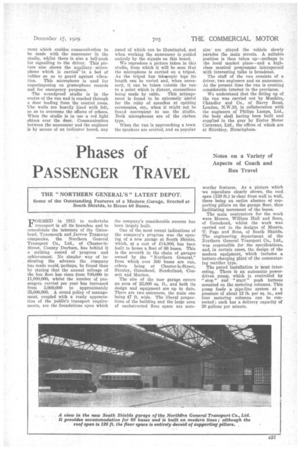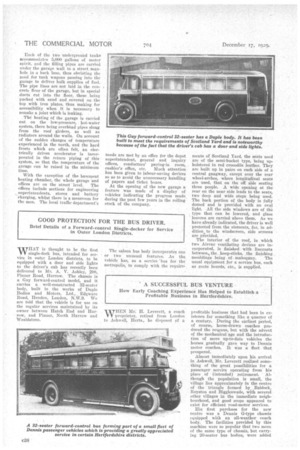Phases of PASSENGER TRAVEL
Page 59

Page 60

If you've noticed an error in this article please click here to report it so we can fix it.
F°'
ill) in 1913 to undertake transport in all its branches and to consolidate the interests of the Gateshead, Tynemonth and Jarrow Tramway companies, the Northern General Transport Co., Ltd., of Chester-leStreet, County Durham, has behind it striking record of progress and achievement. No simpler way of indicating the advance the company has made could, perhaps, be found than by stating that the annual mileage of the bus fleet has risen from 706,000 to 11,000,000, whilst the number of passengers carried per year has increased from 3,000,000 to approximately 35,000,000. A sound policy of management, coupled with a ready appreciation of the public's transport requirements, are the foundations upon which the company's considerable success has been largely built.
One of the most recent indications of the company's progress was the opening of a new garage at South Shields, which, at a cost of £14,000, has been built to house a fleet of 60 buses. This is the seventh in the chain of garages owned by the "Northern General," from which over 300 buses are run, others being at Chester-le-Street, Stanley, Gateshead, Sunderland, Consett and Murton,
The site of the new garage covers an area of 23,000 sq. ft., and both its design and equipment are up to date. There are two entrances, the main one being 47 ft. wide. The liberal proportions of the building and the large area of unobstructed floor space are note worthy features. As a picture which we reproduce clearly shows, the roof span (120 ft.) is clear from wall to wall, there being an entire absence. of Supporting pillars on the garage floor, thus facilitating movement of the buses.
The main contractors for the work were Messrs. William Hall and Sons, of Gateshead, whilst the work was carried out to the designs of Messrs. T; Page and Sons, of South Shields. The engineering department of the Northern General Transport Co., Ltd., was responsible for the specifications, and, in certain cases, the design of the modern equipment? which includes a battery-charging plant of the commutating rectifier type.
• The petrol installation is most interesting. There is an automatic powerdriven pump, which is controlled by "stop" and "start" push buttons mounted on the metering columns. This pump feeds a pipe-line system at a pressure of about 12 lb. per sq. in., and four metering columns can be connected ; each has a delivery capacity of 20 gallons per minute.
Each of the two underground tanks accommodates 5,000 gallons of motor spirit, and the filling pipes are carried under the garage wall to a street, manhole in a back lane, thus obviating the need for tank wagons passing into the garage to deliver bulk supplies of fuel. The pipe lines are not laid in the concrete floor of the garage, but in special . ducts eut into the floor, these being Packed with sand and covered on the top with iron plates, thus. making for accessibility when it is necessary to remake a joint which is leaking. •
The heating of the .garage is carried out on the low-pressure, . hot-water system' there being overhead pipes slung from the roof girders, as well as radiators around the walls. On account of the sudden changes of temperature experienced in the north, and the hard frosts which are often felt, an electrically driven accelerator is incopporated in the return piping of this system, so that the temperature of the garage can be raised in the minimum time.
With the exception of the basement beating chamber, the whole garage and offices are on the street 'level. The offices include sections for engineering superintendents, stores and battery charging, whilst there is a messroom for the men. The local traffic department's
needs are met by an office for the depot superintendent, general and inquiry offices, conductors' paying-in room,
cashier's office, etc. Much attention has been given to labour-saving devices so as to avoid the unnecessary handling of papers and ticket boxes.
At the opening of the new garage a feature was made of a display of vehicles indicating the progress made_ during the past few years in the rolling stock of the company.
ments of Scotland Yard, the seats used are of the semi-bucket type, being upholstered in red crocodile leather. They are built up in pairs on each side of a central gangway, except over the rear wheel-arches, where longitudinal seats are used, that on the off side seating three people. A wide opening at the rear on the near side leads to the seats, two deep and wide steps being used. The back portion of the body is fully domed and is provided with an oval light. All the side windows are of the type that can be lowered, and glass louvres are carried above them. As we have already indicated, the driver is well protected from the elements, for, in addition to the windscreen, side screens are provided.
The interior of the roof, in which two Airvac ventilating devices are incorporated, is finished with lincrusta betvreen0,, the hoop-sticks, .the finishing mouldings being of mahogany. The usual equipment for a service Nis, such as route boards, etc., is supplied.












































































































